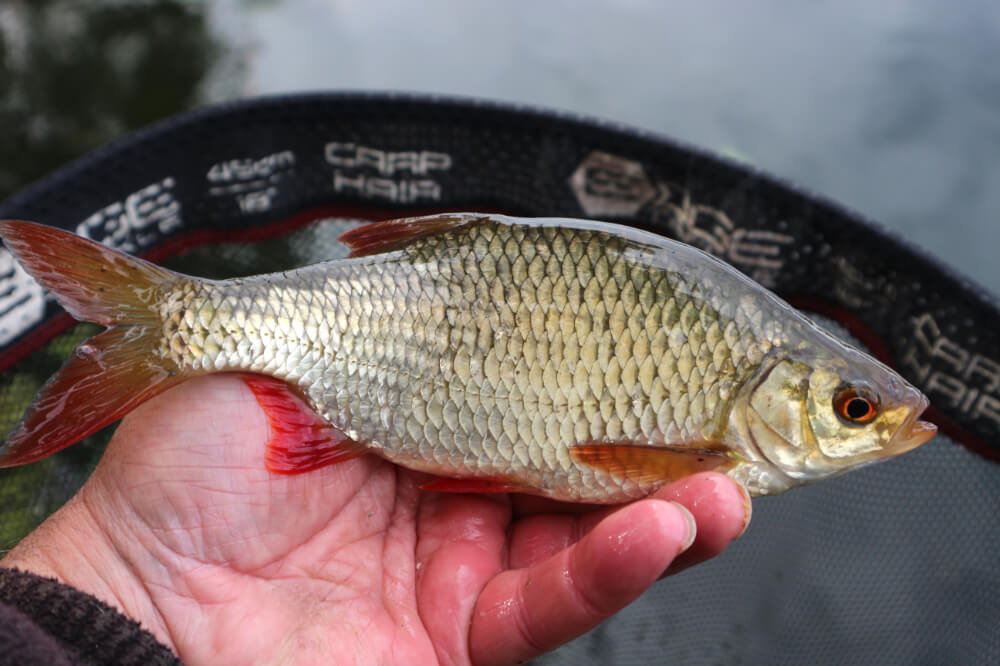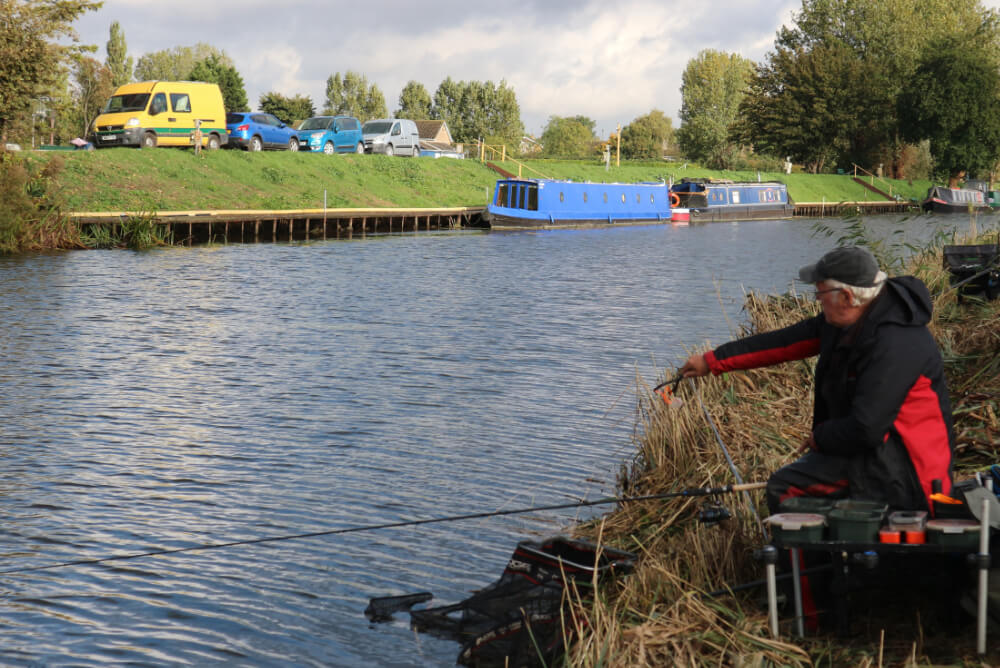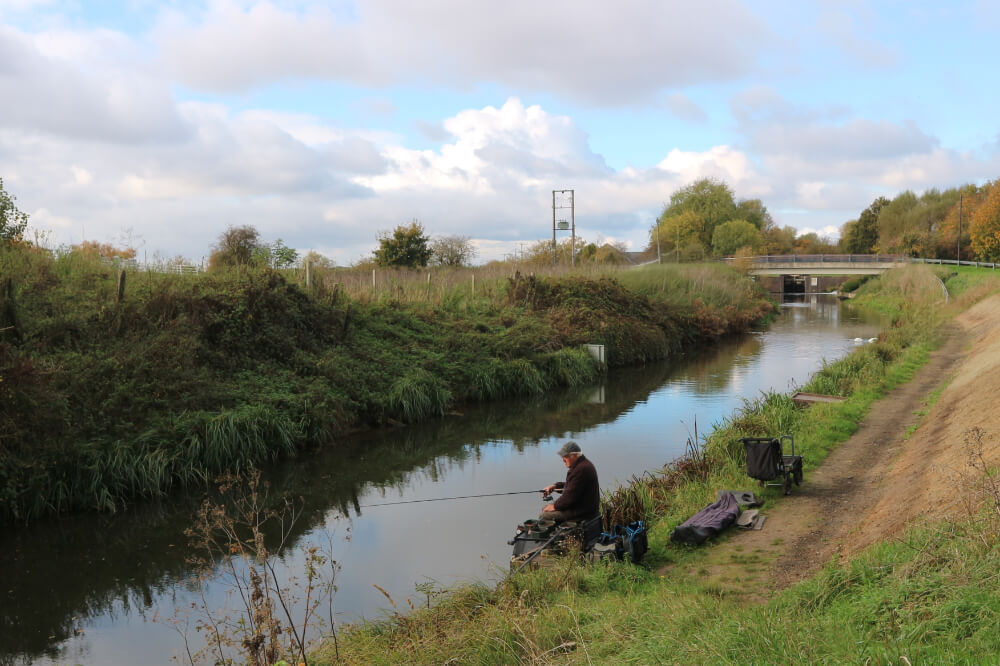Middle Level
Taking a morning stroll along the Old River Nene, I met some anglers who told me I should try a stretch of the Middle Level called Pingle Bridge, which they said had comfortable pegs and was well worth a visit. Navigating a maze of fenland roads, I spotted a couple of pikers perched high on a flood bank, which pointed me in the right direction. There were several decent swims built into the steep banks by the bridge. It was a pleasant spot, with just the predator guys for company and occasional farm machinery rumbling by. I tried the feeder first across to the far bank, but couldn’t buy a bite. There was a good depth and the bottom was clean, but after two hours I gave up on that. Noticing signs of life on the surface closer in, I set up my Cadence CP200 whip at 5 metres with a 2gr olivette rig. Feeding small balls of groundbait quickly woke things up.

Whip Magic
My Cadence whip has seen a serious amount of action in Fenland, mostly at lengths from 5 to 8 metres. Once again, it was about to prove its worth. Small perch turned up first, followed by rudd, then hand-sized skimmers. As I worked the swim up, my groundbait laced with casters began to pull in roach. There were odd dead spells, caused by pike I suspect. However, there were so many fish on my side of the drain, bites were never far away. Groundbait invariably attracts predators with all the small fish it pulls in, but loose feeding is rarely an option on deeper drains. Holding a rig on a tight line to slow down the fall tells you that, invariably finding small rudd and bleak are active higher up. At one stage I thought a pike had grabbed something on the way in, but it was this cracking perch, the highlight of another interesting session.

Close In
Manea Pit had some colour, which presented an entirely new challenge. After previously having to work hard to gain bites, small fish were suddenly swarming over everything that was fed, so I decided to drop short to just a match top kit from my Cadence CP2000 pole. I did this rather than bringing my favourite whip into play, wanting some elastic and extra sections as back up. This was in case any of the decent tench I had been catching from this venue turned up. Feeding a small ball of groundbait every put in, laced with a few pinkies and micro pellets, produced a bite every go with a red maggot. They weren’t big, but roach, rudd, perch, hybrids, and even odd skimmers resulted, fish I was amazed hadn’t been cleaned out by the hungry cormorants that reside here in winter. Two of the predators were already ominously hunting in the distance.

Busy Time
Noticing the carp boys were struggling now the nights were drawing in and getting colder, it was great enjoying plenty of action, even if everything was too small for a landing net to be required. I tried switching to casters, but that didn’t improve proceedings. Hard pellets didn’t work either, and soft ones were smashed up by the bits. It didn’t appear any tench were interested because normally on here they send clouds of bubbles to the surface when they arrive. The only time the small stuff shut up shop was when I suspect a pike was sniffing around. Apart from the small fish I was catching so close in, others were topping everywhere, amazing considering last winter it was hard to buy a bite on this old gravel working. With so many features like islands, bays and canal-like fingers, these prey fish must hide up incredibly well to survive each winter.

An Experiment
Autumn is a good time for the hemp and tare combination, which I hadn’t dabbled with for ages, so I took some to the pit the following week. I wanted to see if seed baits made a difference, hopefully upping the quality factor with so many small fish about. I intended to kick off with groundbait to get things moving, but once I had caught a few silvers, would begin catapulting out small quantities of hemp. I use it ready prepared from a tin these days, after finding raw seeds much trickier to cook properly. I rarely bother fiddling about with the various ways of attaching hemp to the hook, finding nicking a softer tare on much faster and just as effective. I still prepare my own tares, soaking them for a day, draining off, then adding boiling water for an hour. I then bag them up in small quantities and freeze them, so I always have some handy.

A Step Further
There’s not much competition from other anglers with my type of approach on this venue, which is mainly fished by carpers. That means there’s no need to go out very far with the pole, where a top kit plus three sections seemed about right. After cupping in a few balls of groundbait, well laced with micro pellets, casters, and a few pinkies, a red maggot on the hook produced a furry of small fish straight away. A single caster had a similar effect, finding small rudd, roach, and perch. I tried loose feeding some shells, but tiny rudd went mad for them. I also tried directly hooking a soft expander pellet, a bait that normally finds any skimmers if they are knocking about, but that didn’t produce. It was time to start introducing small and regular amounts of hemp, cutting back on the groundbait and trying a small tare on a wide gape size 16 hook.

Another World
If hemp works its magic, you catch better quality silvers straight away, which is exactly what happened here. It didn’t matter if I used a full depth or shallow rig, the rudd got bigger and better stamp roach materialised. I didn’t even have to consider using hemp on the hook because tares were pulling bites every put in. A few were missed, but even when lightly hooked, tares stay attached most of the time. This was probably the biggest rudd and a few of the roach were also this size, the rest being around the 2 to 3oz mark. Good weight builders when catching steadily. I’m not convinced many silvers go that much bigger anyway. There might be an otter fence around this water, but pike and cormorants still influence what survives. No pike problems so far on this occasion, but once again the dreaded winged black creatures were hunting nearby.

Less is More
Not as many fish as last time when swinging into hand with a top kit, but busily shipping my Cadence CP2000 pole over rollers with seed baits produced a much better stamp. It was noticeable that slightly bigger roach turned up after hemp had been fed regularly for a while. It didn’t matter when I had to shallow up considerably, due to there being a jungle of dying lily stalks in the swim, which cost me several hooks. Once the fish were competing for the loose feed, bites were positive and hard to miss. That still applied when I switched to a lightly strung rig, set at less than half depth. The fish were all over it, leaving me to wonder what I might have ended up with in an easier snag free spot. That would have to wait. It was suddenly the time of year when fish begin migrating in the fens, providing even more fascinating places to explore.

The Marina
The bypass stretch of the Old River Nene on the outskirts of March is renowned as a winter hotspot, especially around the mouth of the marina. It’s more accessible now due to a new car park, requiring a key, which you can hire with a deposit from the nearby Mill View Tackle shop. I didn’t want to spoil myself by sitting on a flier peg right on the moorings, so I chose a spot further up near the Middle Level Commissioners headquarters. It looked like waggler country to me. It was still a bit weedy, but gradually I found a line where I could work a float through in the slight flow. It didn’t look like the area just off the moored boats had been fished that much, so it took a while to string together a few bites. I had to catapult small balls of soft groundbait over to get things moving, loose feeding casters over the top and using red maggots on the hook.

Off the Pace
Hungry cormorants were perched on telegraph poles nearby, which is why I suspect the fish tend to shoal close to the busy marina mouth. It’s the hotspot to be on when the big winter league matches take place each year, often providing mega hauls. They can include quality roach, bumper sized rudd and perch, skimmers, bigger bream or even tench. None of that was about to happen sitting on the edges of where all the action normally takes place, but as I worked the swim up, small perch were followed by roach. That were all swingable, so it wasn’t brilliant, but still enjoyable. I imagine these pegs further away from the heavy traffic on the A141 Isle of Ely road improve when they get fed more, which would happen soon when anglers started practising for the forthcoming big events. I need to learn so much more about this venue.

Getting Closer
I returned a few days later and picked a spot much nearer the marina mouth, carefully feeding up a far side waggler line and a shorter one for the pole. I only managed one cast on the running line rig, before a narrow boat moored up opposite and revved its engine for a good ten minutes, while the person hiring it was given lessons in how everything worked. Loads of weed and huge clouds of brown silt churned up. The happy holidaymakers eventually departed on their cruise, leaving me with just the pole option, totally oblivious about what they had done to my plans. It took a good hour before the far side settled down. A quick try over there didn’t produce, so I spent the rest of the session sorting out different pole tactics, which you need to do on here to find the best way of accumulating big catches. I took a few wrong turns but was still kept busy.

Secret River
Something strange occurs on a waterway that’s part of the Nene and Ouse navigation. It begins life as King’s Dyke near Peterborough, but before it metamorphosizes into becoming Whittlesey Dyke, a short stretch is known as the Briggate River. That’s where I was after hearing some good sport can be had around the Ashline Lock area. This part of what is really a drain has some flow, hence its river nickname, I suppose. Picking the wrong day saw the plum section fully taken up with a match, so I went exploring downstream of the lock, running a small stick float under the railway bridge there. Apart from tiny perch, it was lifeless, despite proper fishing stands making it look the part. It would be possible for any fish in here to swim all the way into March unhindered, which is probably where they had gone. A nice spot to try again when the fish come back.





